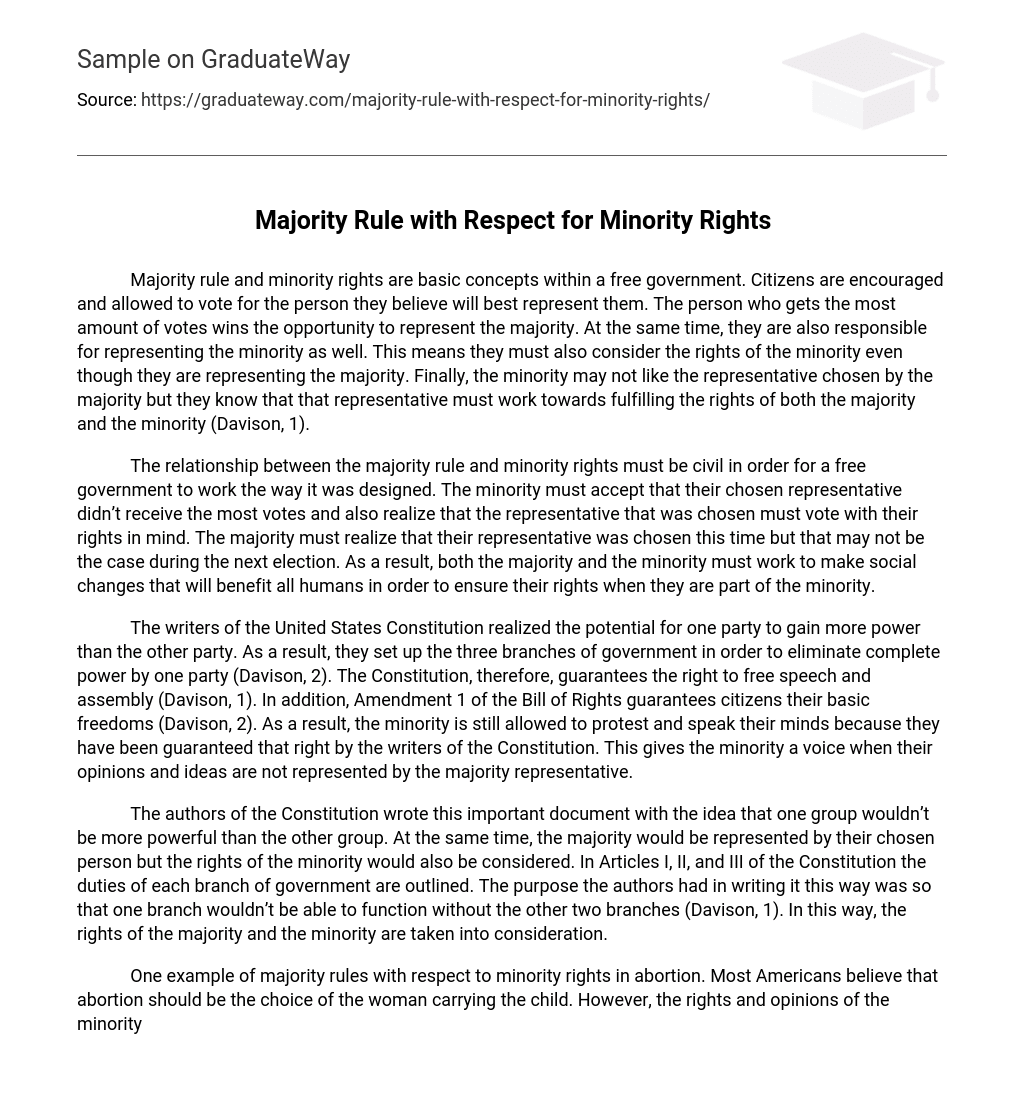Majority rule and minority rights are basic concepts within a free government. Citizens are encouraged and allowed to vote for the person they believe will best represent them. The person who gets the most amount of votes wins the opportunity to represent the majority. At the same time, they are also responsible for representing the minority as well. This means they must also consider the rights of the minority even though they are representing the majority. Finally, the minority may not like the representative chosen by the majority but they know that that representative must work towards fulfilling the rights of both the majority and the minority (Davison, 1).
The relationship between the majority rule and minority rights must be civil in order for a free government to work the way it was designed. The minority must accept that their chosen representative didn’t receive the most votes and also realize that the representative that was chosen must vote with their rights in mind. The majority must realize that their representative was chosen this time but that may not be the case during the next election. As a result, both the majority and the minority must work to make social changes that will benefit all humans in order to ensure their rights when they are part of the minority.
The writers of the United States Constitution realized the potential for one party to gain more power than the other party. As a result, they set up the three branches of government in order to eliminate complete power by one party (Davison, 2). The Constitution, therefore, guarantees the right to free speech and assembly (Davison, 1). In addition, Amendment 1 of the Bill of Rights guarantees citizens their basic freedoms (Davison, 2). As a result, the minority is still allowed to protest and speak their minds because they have been guaranteed that right by the writers of the Constitution. This gives the minority a voice when their opinions and ideas are not represented by the majority representative.
The authors of the Constitution wrote this important document with the idea that one group wouldn’t be more powerful than the other group. At the same time, the majority would be represented by their chosen person but the rights of the minority would also be considered. In Articles I, II, and III of the Constitution the duties of each branch of government are outlined. The purpose the authors had in writing it this way was so that one branch wouldn’t be able to function without the other two branches (Davison, 1). In this way, the rights of the majority and the minority are taken into consideration.
One example of majority rules with respect to minority rights in abortion. Most Americans believe that abortion should be the choice of the woman carrying the child. However, the rights and opinions of the minority are taken into consideration also. For example, this issue of partial birth abortion is an issue that is important to the minority. They don’t agree with the practice of abortion but since it is legal they feel the need to have their wishes represented as well. This includes how late in a pregnancy a woman should be legally allowed to terminate.
A second example is the ever popular issue of gun control. The majority of Americans feel that is should be legal to own a gun if they so choose. However, the minority doesn’t feel the same way because of the issue of safety. Therefore, representatives have had to make laws that protect the rights of the minority as well. These laws mandate the control of guns and who is and who is not eligible to own a gun.
The represented majority are lucky in that their rights and opinions are represented by someone who feels the same way they do. However, it is also important to remember the rights of the minority. In addition, the majority may one day become the minority so the authors of the Constitution were wise in drafting the document in such a way that one group would never be more powerful than another group.
Davison, Brandi. (2006). Majority Rule with Respect to Minority Rights. Associated Content.
Retrieved on September 10, 2008 from
http://www.associatedcontent.com/article/93543/majority_rule_with_respect_to_minority.html?cat=37.





